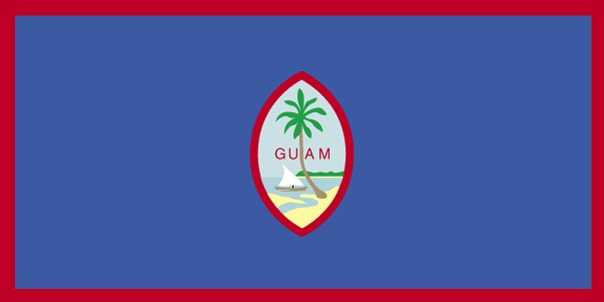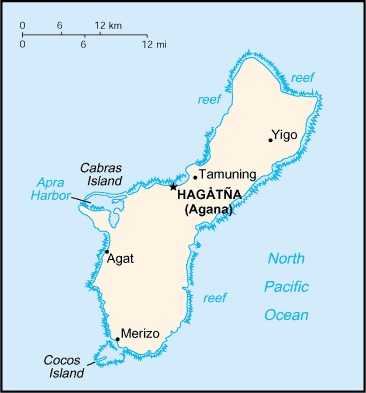Introduction
Background
Spain ceded Guam to the US in 1898. Captured by the Japanese in 1941, the US retook it three years later. The military installations on the island are some of the most strategically important US bases in the Pacific, and they constitute the island’s most important source of income and economic stability.
Geography
Area
total : 544 sq km
land: 544 sq km
water: 0 sq km
Climate
tropical marine; generally warm and humid, moderated by northeast trade winds; dry season (January to June), rainy season (July to December); little seasonal temperature variation
Natural resources
aquatic wildlife (supporting tourism), fishing (largely undeveloped)
People and Society
Population
total: 169,532
Ethnic groups
Native Hawaiian and other Pacific Islander 46.1% (Chamorro 32.8%, Chuukese 6.7%, Palauan 1.4%, Pohnpeian 1.4%, Yapese 1%, other Native Hawaiian and other Pacific Islander 2.8%), Asian 35.5% (Filipino 29.1%, Korean 2.2%, Japanese 1.4%, Chinese (except Taiwanese) 1.3%, other Asian 1.5%), White 6.8%, African descent or African-American 0.9%, Indigenous 0.1%, other 0.6%, mixed 10% (2020 est.)
Languages
English 43.3%, Filipino 24.9%, Chamorro 16%, other Pacific Island languages 9.4%, Asian languages 6.5% (2020 est.)
Religions
Christian (predominantly Roman Catholic) 94.2%, folk religions 1.5%, Buddhist 1.1%, other 1.6%, unaffiliated 1.7% (2020 est.)
Population growth rate
0.11% (2024 est.)
Government
Government type
unincorporated organized territory of the US with local self-government; republican form of territorial government with separate executive, legislative, and judicial branches
Capital
name: Hagatna (Agana)
Executive branch
chief of state: President Joseph R. BIDEN Jr. (since 20 January 2021)
head of government: Governor Lourdes LEON GUERRERO (since 7 January 2019)
Legislative branch
description: unicameral Legislature of Guam or Liheslaturan Guahan (15 seats; members elected in a single countrywide constituency by simple majority vote to serve 2-year terms)
Guam directly elects 1 member by simple majority vote to serve a 2-year term as the delegate to the US House of Representatives; note - the delegate can vote when serving on a committee and when the House meets as the Committee of the Whole House, but not when legislation is submitted for a “full floor” House vote
Economy
Economic overview
small Pacific island US territorial economy; upper income, tourism-based economy; hard-hit by COVID-19 disruptions; relaunched many industries via vaccination tourism; domestic economy relies on multiple military bases; environmentally fragile economy
Real GDP (purchasing power parity)
$5.793 billion (2016 est.)
$5.697 billion (2015 est.)
$5.531 billion (2014 est.)
Real GDP per capita
$35,600 (2016 est.)
$35,200 (2015 est.)
$34,400 (2014 est.)
Agricultural products
fruits, copra, vegetables; eggs, pork, poultry, beef
Industries
national defense, tourism, construction, transshipment services, concrete products, printing and publishing, food processing, textiles
Exports
$186 million (2021 est.)
$371 million (2020 est.)
$1.403 billion (2019 est.)
Exports - partners
Singapore 30%, Taiwan 20%, South Korea 14%, Philippines 12%, Hong Kong 8% (2022)
Exports - commodities
refined petroleum, scrap iron, scrap copper, trunks and cases, aircraft parts (2022)
Imports
$3.667 billion (2021 est.)
$3.383 billion (2020 est.)
$3.552 billion (2019 est.)
Imports - partners
South Korea 37%, Singapore 35%, Japan 12%, Taiwan 3%, Hong Kong 3% (2022)
Imports - commodities
refined petroleum, cars, raw iron bars, electric generating sets, trunks and cases (2022)
Page last updated: Wednesday, July 24, 2024




